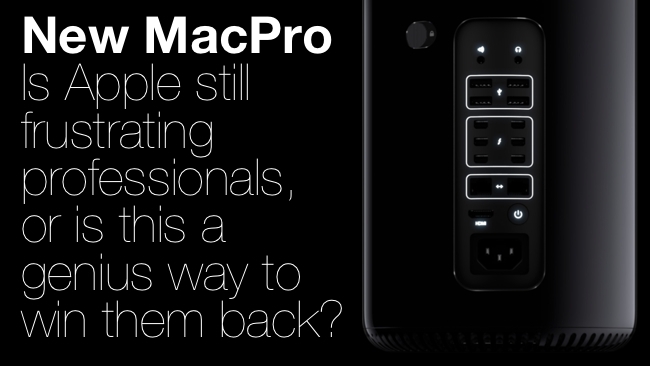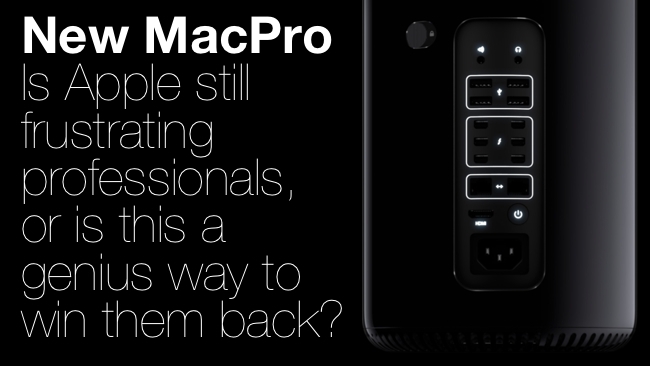
 New Mac Pro
New Mac Pro
Is the new Mac Pro the machine all the professionals have been waiting for - or is it beautifully designed but half-baked attempt to win back users who need an expandable, flexible workstation? RedShark contributor Miguel Ferros investigages
As the dust settles on another Apple World Wide Developer Conference the bulk of those that give a damn are dreaming of a lovely new interface for iOS whilst others are chatting excitedly about using the new MacBook Air for an entire long-haul flight without having to buy an airline power adapter. But what of the long-suffering TV or Film professional, so long the stalwart of the Apple ecosystem? Does the new MacPro finally give them real hope of a future that doesn’t leave them dragging hopelessly behind their PC-based counterparts in power, flexibility and, in effect, competitiveness
FCP X Roller Coaster
Ever since the mishandling of the introduction of FCP X and the concurrent demise, resurrection, demise of Final Cut Studio it has felt like Apple has lost the love for our industry. Even though FCP X has seen great improvements from the difficult launch of the iMovie look-alike (which actually, apparently, shared very little code with its less-ambitious relative), the lack of a refresh for the MacPro has led many to believe that a future built on Apple was not a viable one at all. Now, finally, the announcement is made, the specs (or lack of) pawed over and the reaction is filtering in. Does anybody believe anything has changed?
Vague
Let’s first look at the actual announcement and try and read between the lines. Experience will tell us that these types of announcements are deliberately vague, balanced to enthuse customers and, more pertinently, investors, whilst allowing plenty of wiggle room for adjusting specs prior to shipping.
In short, it is not always wise to expect the best. For example, many commentators have reported that the new chipset is based on Intel’s Haswell micro architecture whereas there has been no public statement by Apple to support this. Indeed, the Haswell chips should give a times-four increase in performance over the current processor but Apple is only claiming a times-two improvement. Would they pass up a chance to stoke the market if they were committed to Haswell?
Similarly, Apple states that the new Processor is “the new-generation Intel Xeon E5 chipset” that doesn’t yet exist. The C600 chipset does support the E5 family but officially only offers PCI-Express 2.0; yet Apple is claiming PCIe 3.0 capability in the new MacPro. So the situation is unclear but the new MacPro might just as likely be Ivy Bridge as Haswell.
Leapfrogging?
Why does this matter? It only does in terms of Apple’s approach and if you are a video pro looking for an indication that Apple are making a statement of a commitment to your business. If you have suffered the long wait for a hardware refresh it would be nice to see that Apple are leapfrogging the competition, rather than just playing catch-up.
In those terms, the other feature announcements are clearer and definitely more positive. PCIe-based Flash storage will boost storage performance well above the current offering and even beyond SATA 6G. It is unclear which AMD twin graphics cards will be used (unless a new one will be announced ready for shipping of the MacPro) but 60GB/s across four channels will handle the most demanding operations. On the face of it, looking optimistically at the announcements, this new machine is better, faster and smaller but, for video work, the demands are not always straightforward.
Flexibility
One of the biggest issues is flexibility: over the lifecycle of a piece of general purpose hardware we can expect to see several revs of GPU capability, codec releases and an unending demand for greater amounts and speeds of storage. Apple would point to the large number of high-speed connections of the new MacPro as their response to this very problem. In other words, you don’t need to cram more into a bulging housing, you just hang more off it, as and when you need to. It’s a beguiling argument but what do the pros think to it?
Expansion
Lots of connections generally mean an expansion chassis, which tend to be big and ‘boxy’ with fans. Where else will the required Red Rocket cards, Raid Array Controllers and Raid Arrays go? So the nice new quiet designer-look MacPro on the desktop will come with cables dangling down to a big box with a big fan, or it goes in the machine room, in which case all the angst and hours that went into designing a groundbreaking new system leaves just one question - how does it go in a rack?
David Garcia, Creative Director at Halflife Digital doesn’t see that as a huge issue: “We have several great setups working with iMacs and Macbooks with expansion chassis and mobile rigs. It doesn't seem like that's a huge problem and if Thunderbolt 2 supports GPUs in the chassis that is pretty much its last hurdle. But yeah, how do you put it in a rack?”
Rack it?
To rack or not to rack is an issue and there were rumours that the new MacPro would only be available as a rack unit. How seriously that was considered is something only insiders can tell us but clearly Apple has felt it necessary to stay in the desktop market. “It’s their way of staying in the game without playing the game” thinks Parke Gregg, colorist and finisher at Stuck On On. “They've made a MacMini with a workstation processor and lots of expansion ports. This puts much of the ‘pro’ features on third parties and this is good a thing. As far as being rack-mountable, the current MacPro isn't either. The ones we have now simply lie on a shelf in the rack. This little Mac R2 unit [a reference to the new design’s similarity to a certain holograph projecting droid- Ed] will just sit on that same shelf: I guess a few could.”
It may work...
The consensus therefore seems that, performance-wise and putting GPU support aside, the ‘hang it all off’ policy may work. There are, and will be, complaints but the only thing that will remove that is the price. If the pricing is aggressive and basically ‘cheap’, due to all of its integration, then people will look beyond the limitations; treating it as an expendable appliance.
Parke Gregg’s take on that? “Every time we get a MacPro it ends up being about US$9000. I'm guessing this new MacPro will be about the same with an expansion chassis, etc. However, with this modular approach, the next time we upgrade, we won't have to buy all the modules again. I like this idea a lot.”
Joel Hruska, in his ExtremeTech blog, counters that the new paradigm is actually going to be more expensive, at least initially: “The new reliance on Thunderbolt may be troubling for anyone who wasn’t planning on upgrading all of their peripherals… This is the least expandable Mac Pro in decades. It may offer more Thunderbolt connectivity than any system ever has, but as far as compatibility with current-generation hardware, it’d be hard to find a workstation less expandable than this one.”
So although there are gripes and likes what there doesn’t seem to be, amongst those who use Apple, is a serious concern over its viability within their high-performance high-demand businesses. There is certainly concern over the limited option of GPUs but until the details come out as to the actual card and how well OpenCL is supported to match CUDA the jury is out.
Leading companies use CUDA and Open CL
Today, leading companies such as Adobe, Assimilate and Blackmagic Design have been updating their software to take advantage of either CUDA or OpenCL. Some of the camera vendor RAW SDKs use OpenCL, some use CUDA. Other companies, like The Foundry, GenArts or Cinnafilm, currently only offer CUDA versions. In addition large companies like Industrial Light & Magic and Weta Digital create CUDA-based tools for their own use to create fast, efficient pipelines for their artists: they will be keeping a close eye on the GPU situation.
Thunderbolt 2.0 may not be fast enough
It is worth stating that Thunderbolt 2.0 is not fast enough to run high-resolution real-time graphics processors externally. So, having bought that expansion chassis and hung it off the back of the Mac Pro, it will still not be possible to get the kind of performance one would with an onboard graphics card.
Apple have trumpeted loudly on the new architecture’s ability to run three 4K displays simultaneously without slowing down operations. This is very likely true for video editing and there is many an editor that will salivate at the idea of spreading their bins over such a large desktop area but, and it is a big but, the whole idea does sort of play back into the starting question of how seriously is Apple taking the Pro market? Are they only concerned about FCP X (of course, Avid, Adobe et al also benefit, although any users of 3rd party cards will have to expensively upgrade to Thunderbolt 2)?
The trite answer is, naturally, yes, their first thought is to their remaining professional video app, and serving its users. And of the flexibility that pro users require? Apple seems to be following their standard line of ‘build it powerful and sexy enough that they (the customer) will overlook the shortcomings’, but this could be an error. What if, for example, people find their systems slowing down at critical times as their GPU accelerated applications share resources with their expensive 4K Displays?
Shopping list
Is this where additional GPUs in the expansion chassis come into play? We don’t yet know the answer to this but it is a concern and it does remind us that, in all probability, by purchasing a new Mac Pro for professional work, one will be simply creating a shopping list for peripherals.
Tags: Business


Comments